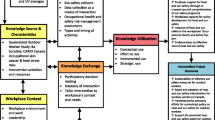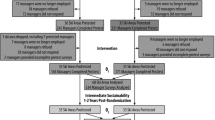Abstract
Objectives: A graded worksite intervention program to improve sun protection and skin cancer awareness of outdoor workers was implemented and evaluated longitudinally over a period of 20 months.
Methods: Outdoor male workers (144/213 recruits) from geographically separated units of the Israel National Water Company were allocated to complete (n = 37), partial (n = 72) or minimal (n = 35) intervention groups. Subsequent to the assignment and training of local safety officers, an educational and medical screening package was provided to the corresponding groups either once, or repeatedly a year later. Personal sun protective gear was provided upon repeated intervention. Outcome measures were evaluated through self-response questionnaires administered prior to the first intervention pulse, and 8 months after the first and second interventions.
Results: A 15–61% improvement in sun-protection habits was noted in the entire study population 8 months after initialization, compared to no sunscreen use, 20% sun-exposed skin area and highest mean occupational exposure dose of 1.68 MED/day at pre-test. An even greater use of sunscreen was evident 1 year later in the complete and partial intervention groups, + 80% and + 52%, respectively. The baseline rate of self-examination of the skin in the same two groups (49%) increased significantly at post-test (+ 71% and + 53%, respectively).
Conclusions: This integrated intervention program led to significantly improved sun protection and skin cancer awareness. Repeated intervention combined with the supply of sun-protective gear contributed to an even greater impact.
Similar content being viewed by others
References
American Cancer Society (1996) Cancer Facts and Figures. Atlanta, GA: American Cancer Society.
International Agency for Research on Cancer, ed. (1992) IARC Monographs on the Evaluation of Carcinogenic Risks to Humans. Lyon: International Agency for Research on Cancer, Vol. 55.
Holman CD, Gibson IM, Stephenson M, Armstrong BK (1983) Ultraviolet irradiation of human body sites in relation to occupation and outdoor activity: field studies using personal UVR dosimeters. Clin Exp Dermatol 8: 869–871.
Armstrong BK, Kricker A (1996) Epidemiology of sun exposure and skin cancer. In: Leigh IM, Newton Bishop JA, Kripke ML, eds. Skin Cancer. New York: Cold Spring Harbor Laboratory Press, pp. 133–153.
Beral V, Robinson N (1981) The relationship of malignant melanoma, basal and squamous cell cancers to indoor and outdoor work. Br J Cancer 44: 886–891.
Vagero D, Ringback G, Kiviranta H (1986) Melanoma and other tumors of the skin among office, outdoor and indoor workers in Sweden. Br J Cancer 53: 507–512.
Dubin N, Moseson M, Pasternack BS (1989) Sun exposure and malignant melanoma among susceptible individuals. Environ Health Perspect 81: 139–151.
Azizi E, Modan M, Fuchs Z, Kushelevsky A (1990) Identification of workers in Israel at increased risk for skin cancer due to occupational over exposure to the sun. Harefuah 118: 508–511.
Cristofolin M, Bianchi R, Boi S, et al. (1993) Analysis of the cost-effectiveness ratio of the health campaign for early diagnosis of cutaneous melanoma in Trentino, Italy. Cancer 71: 370–374.
World Health Organization (1994) Summary and conclusions. In: Environmental Health Criteria; 160. Ultraviolet Radiation. Geneva: World Health Organization, pp. 1–7.
Elwood JM, Morris JM (1996) Evaluation of programs to modify sun exposure. In: Mackie RN, ed. Primary and Secondary Prevention of Malignant Melanoma. Basel Karger, pp. 111–117.
Cummings SR, Tripp MK, Herrmann NB (1997) Approaches to the prevention and control of skin cancer. Cancer Metastasis Rev 16: 309–327.
Koh HK, Geller AC (1998) Public health interventions for melanoma. Prevention, early detection, and education. Hematol Oncol Clin N Am 12: 903–928.
World Health Organization (1994) Human Studies: The Skin. In: Environmental Health Criteria; 160 Ultraviolet Radiation. Geneva: World Health Organization, pp. 127–173.
World Health Organization (1994) Human Studies: The Eye In: Environmental Health Criteria; 160. Ultraviolet Radiation. Geneva: World Health Organization, pp. 181–207.
Fitzpatrick TB (1988) The validity and practicability of sun-reactive skin types I through VI. Arch Dermatol 124: 869–871.
Gottlieb A, Bourget TD, Lowe NJ (1990) Sunscreens: effect of amounts of application of sun protection factors. In: Lowe NJ, Shaath NA, eds. Sunscreens: Development, Evaluation and Regulatory Aspects. New York: Marcel Dekker, pp. 441–446.
Azizi E, Pavlotsky F, Kushelevsky AP, et al. (1994) Estimation of skin cancer risk due to occupational exposure to sunlight in Israel. Final Scientific Report. The Committee for Research and Prevention in Occupational Safety and Health. Jerusalem: Ministry of Labour and Social Affairs.
Kudish A, Evseev E, Kushelevsky AP (1997) The analysis of ultraviolet radiation in the Dead Sea basin, Israel. Int J Climatol 17: 1697–1704.
Shani E, Rosenberg L, Glesinger R, Sadetzki S, Solomon A, Azizi E (1998) Prevention of skin cancer and actinic eye disease in outdoor workers of “Mekorot”-a longitudinal feasibility study. Final Scientific Report. The Committee for Research and Prevention in Occupational Safety and Health. Jerusalem: Ministry of Labour and Social Affairs.
Girgis A, Sanson RW, Watson A (1994) A workplace intervention for increasing outdoor workers' use of solar protection. Am J Public Health 84: 77–81.
Borland RM, Hocking B, Godkin GA, Gibbs AF, Hill DJ (1991) The impact of a skin cancer control education package for outdoor workers. Med J Aust 154: 686–688.
Stepanski BM, Mayer JA (1998) Solar protection behaviors among outdoor workers. J Occup Environ Med 40: 43–48.
Berwick M, Begg CG, Fine JA, et al. (1996) Screening for cutaneous melanoma by skin self-examination. J Natl Cancer Inst 88: 17–23.
Lerman Y, Shemer J (1996) Epidemiologic characteristics of participants and nonparticipants in health-promotion programs. J Occup Environ Med 38: 535–538.
Author information
Authors and Affiliations
Rights and permissions
About this article
Cite this article
Azizi, E., Flint, P., Sadetzki, S. et al. A graded work site intervention program to improve sun protection and skin cancer awareness in outdoor workers in Israel. Cancer Causes Control 11, 513–521 (2000). https://doi.org/10.1023/A:1008970224998
Issue Date:
DOI: https://doi.org/10.1023/A:1008970224998




